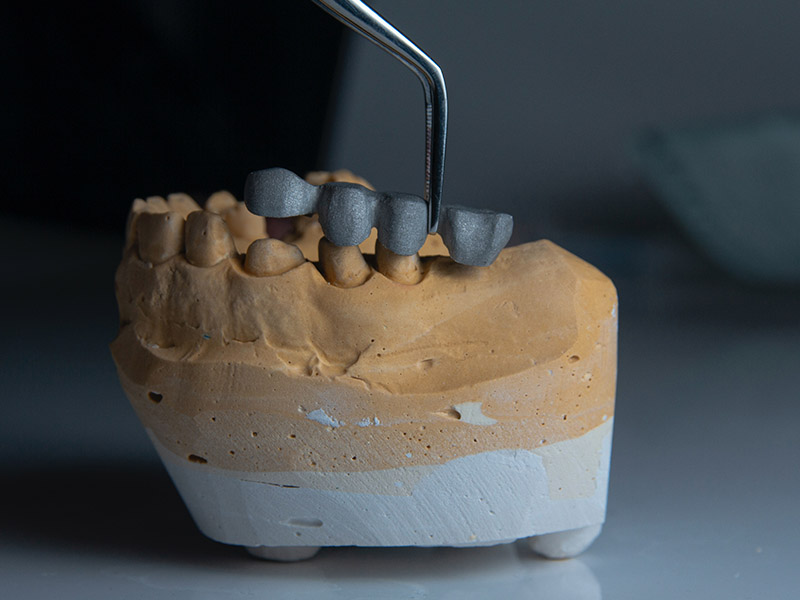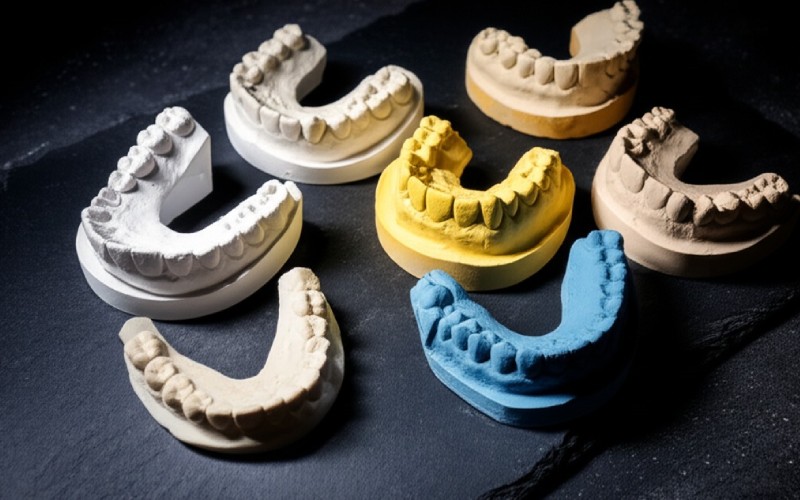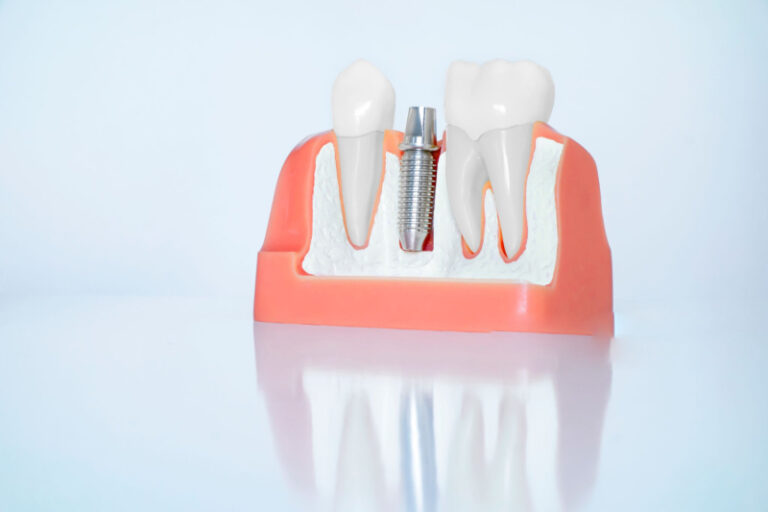
A Guide to the Different Types of Dental Plaster: Creating the Perfect Dental Model Replica
In the world of dentistry, the type of dental plaster or dental stone you use is a huge deal. It can be the difference between a crown that fits perfectly and one that has to be remade. This article is for anyone who wants to understand these materials better. We will look at the different types of dental plaster and stone. We will see why making an accurate dental model is so important for good patient care.
Table of Contents
What Is Dental Plaster and Why Is It Used in Dentistry?
Dental plaster is one of the most common materials in any dental office or laboratory. At its core, dental plaster is a powder made from a mineral called gypsum. This gypsum is a form of calcium sulfate. When you mix this powder with water, a chemical reaction starts. It causes the mix to harden into a solid mass. We use this to create a replica of a patient’s teeth and oral structures. This replica is called a dental model or a dental cast. The model gives the dentist a way to study a patient’s mouth without the patient being there.
This simple material is key to the field of dentistry. The dental models created from plaster are used for many things. They help in treatment planning and making a diagnosis. For example, an orthodontic specialist uses a dental model to plan how to move a tooth. It’s also used for the fabrication of almost every dental appliance you can think of. From a simple mouthguard to a complex denture or bridge, the journey often starts with a plaster model. The type of dental plaster used depends on the job. Some jobs need more strength and precision than others.
The beauty of dental plaster is that it can capture very fine details from a dental impression. An impression is a mold taken of the patient’s mouth using a soft material like alginate. When you pour the plaster mix into this impression, it flows into every tiny space. As it hardens, it creates a very precise copy. This accuracy is so important. A good dental model is the foundation for a successful restoration. Without a good model, it’s almost impossible to fabricate an appliance that fits well.
Why Are Accurate Dental Models So Important?
A dental appliance is made, and it just doesn’t fit. The patient is unhappy, and the dentist is frustrated. Most of the time, the problem can be traced back to the dental model. If the model is not an exact replica of the patient’s mouth, the appliance made from it will not fit. That is why accuracy is everything when it comes to creating dental models. A tiny error in the model can lead to a big problem with the final restoration.
Think about what these dental models are used for. They are used to make things that go into a person’s mouth. This includes a crown, a bridge, or orthodontic appliances. These items need high precision to work correctly and be comfortable. For example, a dental crown must fit over a prepared tooth perfectly. If the model was not accurate, the crown might be too loose or too tight. This can lead to future dental problems. An accurate dental model ensures that the final appliance will fit just right.
This need for accuracy affects every step. It starts with taking a good dental impression. Then, you must choose the right type of dental plaster or stone. You also have to mix it correctly. Even a small change in the water-to-powder ratio can affect the expansion or shrinkage of the plaster as it sets. This can change the size of the final model. Good patient care depends on this attention to detail. An accurate dental model is a key part of modern dentistry.

What Are the Different Types of Dental Plaster and Dental Stone?
Not all plaster is the same. There are different types of dental plaster and stone, and each has its own job. The American Dental Association (ADA) groups them into five types. Let’s look at the most commonly used ones. Type 1 is impression plaster, which is not used much anymore. Type 2 is regular dental plaster, often called “plaster of Paris.” It is great for creating a preliminary model for diagnostic purposes or for attaching models to a machine called an articulator. It is relatively soft and not very strong.
Type 3 dental stone is a step up. It is harder and stronger than Type 2 plaster. This makes it a widely used material for making dental models for a denture. It is often used to create a model of the opposing arch to check the bite. This type of dental stone, sometimes just called “stone,” offers a good balance of strength and cost. It’s a workhorse material in many dental labs. Its properties of dental strength make it suitable for tasks that don’t need the highest level of precision but still require a durable model.
For jobs that demand the highest accuracy and strength, we use Type 4 and Type 5 dental stones. These are often called “die stones.” They have high compressive strength and low setting expansion. This means they are very strong and do not change size much as they harden. This precision is needed to fabricate a precise crown, bridge, or implant appliance. The fabrication of these items requires a model that is an exact replica of the prepared tooth. Any error could ruin the fit. These stones are more expensive, but their accuracy is worth the cost.
How Do I Choose the Right Type of Dental Plaster for My Application?
Choosing the right type of dental plaster or stone is a critical decision. The choice depends entirely on what you are going to use the dental model for. You must ask yourself: what is the final goal? If you are making a diagnostic model to simply look at the teeth, a Type 2 dental plaster might be fine. These diagnostic models help with visualization and treatment planning. They don’t need to be super strong, so a less expensive plaster will do the job.
However, if you need to fabricate a dental appliance on the model, you need something stronger. For making a full or partial denture, a Type 3 dental stone is a great choice. It has the hardness and strength to withstand the fabrication process. It provides a good level of accuracy for this type of application. Many orthodontic models are also made from Type 3 stone because it is durable enough to handle the bending of wires for orthodontic appliances. The advantage of this type is its versatility.
When it comes to high-precision work, you must use a high-strength stone. For creating a model for a crown, bridge, inlay, or implant restoration, you should always choose a Type 4 or Type 5 dental stone. These restorations require extreme accuracy. The dental model must be strong enough to not break or wear down during the fabrication process. It must also have very low expansion to ensure the final appliance fits the tooth perfectly. Using a weaker plaster for this kind of work is a recipe for failure.
What Is the Process for Creating a Dental Model from an Impression?
Creating dental models is a careful process. It all starts with the dental impression. A dentist or dental assistant takes an impression of the patient’s teeth and soft tissue. This is usually done with a flexible material like alginate. The impression is a negative mold of the mouth. The goal is to pour a material into this mold to create a positive replica, which is the dental model.
Once you have a good impression, it’s time to pour the model. First, you select the correct type of dental plaster or dental stone for the job. You then measure the powder and water exactly. You must follow the manufacturer’s instructions. Mixing is next. You add the powder to the water and mix it until it is smooth and creamy. You want to avoid trapping air bubbles in the mix. Trapped air can cause holes in your final dental model.
After mixing, you pour the mix into the impression. This is done slowly and carefully, often using a small vibrator to help the material flow into all the details of the impression. It also helps any trapped air bubbles rise to the surface. You start at one end of the impression and let the plaster flow around the arch. Once the impression is full, you can create a base for the model. The plaster will then harden. The time it takes to harden, or the setting time, varies depending on the type of material used.
What Makes Dental Stone Different from Regular Dental Plaster?
I used to wonder what the big deal was between plaster and stone. They both come from gypsum, right? The difference is in how they are made. Both dental plaster and dental stone are made by heating gypsum, which is calcium sulfate dihydrate. The heating process removes some of the water, turning it into calcium sulfate hemihydrate. However, the way it’s heated is different. Regular dental plaster (Type 2) is made by heating the gypsum in open air. This creates powder particles that are rough and porous.
Dental stone (Type 3, 4, and 5), on the other hand, is made by heating the gypsum under pressure. This creates powder particles that are more dense, regular in shape, and less porous. Because these particles are less porous, you need less water to mix them. A mix with less water results in a final product that is much stronger and denser. This is the main reason why dental stone is so much stronger than dental plaster.
This difference in strength and density has a huge impact on the application of the material. The porous nature of plaster makes it weaker and more prone to breaking. It’s fine for a simple diagnostic model. But for a working model used to fabricate an appliance, you need the strength of dental stone. The dense surface of a dental stone model is also more resistant to abrasion. This means it won’t wear down as you work on it, which helps maintain the accuracy of the model.
How Does Accuracy in a Dental Model Affect a Crown or Bridge?
The fit of a dental crown or bridge is all about precision. We are talking about measurements that are smaller than the width of a human hair. The only way a dental laboratory can fabricate a restoration with that kind of accuracy is by using an equally accurate dental model. This model acts as a stand-in for the patient’s tooth. If the model is wrong, the crown will be wrong. It’s that simple.
Several factors in the dental stone affect this accuracy. One is compressive strength. The model needs to be strong enough to not chip or break while the technician is working on it. Another key factor is setting expansion. All gypsum products expand a little bit as they set. However, high-quality dental stones are designed to have very low expansion. If a model expands too much, the crown made on it will be too large and won’t fit tightly on the real tooth.
This is why using a Type 4 or Type 5 dental stone is so important for this kind of restorative work. These materials are engineered for high precision and low expansion. This ensures that the dental model is a true and stable replica of the patient’s oral condition. This allows the dental technician to fabricate a crown or bridge that fits perfectly, providing comfort, function, and longevity for the patient. A good model supports a good outcome.

What Are the Advantages of Using a High-Quality Dental Stone?
When you’re in the business of creating things that affect people’s health, cutting corners is never a good idea. Using a high-quality dental stone has several clear advantages. The biggest advantage is accuracy. Premium dental stones offer high precision, low expansion, and excellent detail reproduction. This means your dental model will be a more faithful replica of the patient’s mouth, leading to a better-fitting dental appliance.
Another advantage is strength and durability. A high-quality dental stone has high compressive strength. This makes the model resistant to breaking or chipping during the fabrication process. Technicians can work on the model with confidence. The surface hardness also prevents the model from wearing down. This is important when you are making fine adjustments to a crown or prosthetic appliance. A durable model ensures that the accuracy is maintained from start to finish.
Finally, a good dental stone can save time and money in the long run. While it might cost a bit more upfront, it reduces the risk of having to remake a dental appliance. Remakes are costly. They waste materials, time, and require the patient to come in for another appointment. By investing in a quality material that produces a reliable and accurate dental model, you increase the chances of getting it right the first time. This leads to more efficient work and better patient care.
What Is the Best Way to Mix Dental Plaster?
Proper mixing is a skill, and it’s one that directly impacts the quality of your dental model. Even the best dental stone can be ruined by a poor mix. The first rule is to always follow the manufacturer’s instructions. The instruction sheet will tell you the exact water-to-powder ratio. Use a scale to measure the powder and a graduated cylinder for the water. Guessing is not good enough if you want accuracy.
When you are ready to mix, always add the powder to the water. Do not do it the other way around. Adding the powder to the water helps wet each particle evenly and reduces the chance of trapping air. Mix with a clean spatula in a clean, flexible rubber bowl. Mix with a wiping motion against the side of the bowl. This will help break up any clumps and create a smooth, homogenous mix. Try not to whip the mix, as this will introduce air bubbles.
A great tip is to use a dental vibrator while mixing and pouring. Placing the bowl on the vibrator for a few seconds after mixing will help any trapped air bubbles come to the surface. This will give you a denser, stronger final model. A good mix should be creamy and smooth, not too thick and not too runny. Following these steps will help you get the best properties of dental plaster or stone and will lead to a better dental model.
How Do You Care for a Finished Dental Model?
Once you have created a beautiful, accurate dental model, you need to take care of it. A dental model can be fragile, especially if it is made from a softer plaster. The first step is to let it set completely. Most materials need at least 45 to 60 minutes to gain enough strength to be handled. Follow the manufacturer’s recommendation for the full setting time. Don’t try to separate the model from the impression too early, as you might break a tooth off the model.
After the model is separated from the impression, you may need to trim it. This is often done to create clean model bases and a neat appearance. Use a model trimmer with plenty of water to keep the dust down and prevent heat from damaging the model. Be careful not to trim away any important anatomical details. For orthodontic models, the articulation and arch shape are very important.
For storage, keep your dental models in a safe, dry place where they won’t be knocked over or damaged. Label them clearly with the patient’s name and the date. Storing models in a dry place is important because gypsum can absorb moisture from the air, which can weaken it over time. Proper care and storage ensure that the dental model remains an accurate record that can be used for future reference or treatment planning. The longevity of the model depends on it.




